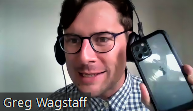Teaching Through Play: Using Role-Playing-Games to Teach English
Diving into the realm of fantasy and role-play is a foolproof way of getting your students to step up their language game (pun intended). Find out more about this communicative approach to learning English.
“You have been travelling through the galaxy for three days when you see the space station. It is enormous, but dark, with no shimmering lights or glowing windows. It doesn’t look like anybody has lived here for decades – the crew went radio silent thirty years ago while they were mining rare metals from a nearby asteroid and nobody knows what happened to them. It’s your job to find out. What do you do?”
In these five sentences we see the present perfect progressive and past progressive tenses, the present perfect simple, past and present simple, and two different forms of the auxiliary verb ‘do’.
But rather than thinking about the English, most people will be thinking about the spaceship when giving their responses, whether asking questions:
“Is the space station damaged?”
“How many people were working there?”
…or creating a plan of action:
“I think we should scan it for life.”
“We need a doctor, a soldier and a scientist. I’ll sneak in first.”
… The communicative purpose of the language comes to the fore. Students will use it naturally as it exists in the real (or fantastical) world.
Consider how much more interesting an RPG scenario – buying an invisibility potion from a surly orc – is than the textbook equivalent of the same language – buying bread and milk from a supermarket clerk. The latter example also offers no reward beyond praise; the former could be essential to their characters’ in-game success.
Role-playing games or RPGs are a fantastic way to learn English. They are basically ‘interactive stories’ and use a wide range of vocabulary and functional language, which must be used to convey complex ideas – often in a much more interesting and dynamic way than counterpart textbook exercises.

Some basic principles of role-playing games
RPGs come in a multitude of forms, covering every genre imaginable, but a fairly typical (sci-fi) game might proceed like this:
The Game Master, or GM, tells a story, and the players each represent characters (a dashing pilot, a cowardly robot technician, etc). The players might act or talk in-character, but they all make decisions and take actions. A die (or dice) is usually rolled to decide the results of an action, and the story continues:
[Player] “I want to scan the space station for life. I rolled a 14 on the die.”
[GM] “A 14? That’s a pass! Your ship’s computer detects a very faint, human heartbeat deep inside the ship. And also, something else… The computer doesn’t know what it is, but it’s not human. What do you do next?”
Thanks to their variety, these games are suitable for a huge range of learners – I have played a simple example of the genre, No Thank You, Evil!, with ESL students as young as seven. These are not just kids’ games, however – having really taken off in the late 1970s, RPGs have fans of all ages.
Furthermore, their variety comes not just in complexity and genre, but in entire philosophy – The Quiet Year is a game in which players work together to draw a map and tell the story of a single year in the life of an isolated village. There are no dice, and no GM – prompts come from drawing cards (“Which group holds the highest status in your community? How does one gain access to this group?”).
Very often, it’s not a matter of whether you like RPGs, but which one is suitable for you.

Tips and tricks for using role-playing games in the classroom
Role-playing games are becoming part of the zeitgeist. The YouTube Show Critical Role aimed to crowdsource $750,000… and raised a record $11 million! New games are springing up, and new players are joining every day. Now is the perfect time to introduce them into your classroom…
… and that brings me to a little bit of self-promotion. I’m developing a gaming session for kids in Berlin; having run some trials, it will be launching very soon. I won’t sell it too hard here (though please check out our social media!), but here are some tips and tricks I’ve picked up along the way…
- Find a game that suits your audience! Dungeons and Dragons (D&D) is by far the most popular; your students might have already played it, or want to. It isn’t the simplest or easiest, though. For my game I use the Cypher System, as it can be adapted to any story genre and copes well with whatever left-field actions younger players want to take. It also, very importantly, requires little maths or arcane rules-knowledge when under pressure.
- Find a story that suits your audience! Even within one game, there are many different stories to choose from (just as there is a difference in sci-fi between Star Wars, Alien and 2001: A Space Odyssey). You can write your own stories, buy ready-made stories, or mix these approaches. This can tie in to my first tip – popular games such as D&D have a lot of material ready-made. Other perfectly good, but less popular, systems will require more preparation on your part.
- Introduce your target language! Even without any extra work, these games are great for language use. Vocabulary will be introduced and reused and language will be deployed in service of a tangible goal. You can alter the script for your story to make sure it covers the language you want your students to hear (e.g. “People have visited this shrine for hundreds of years…”). I also customised my game to offer bonuses to die rolls if English questions are answered correctly.
- Introduce other activities! Students could draw pictures of their characters to match the descriptions they have written, or draw maps of these characters’ home towns. They could prepare a speech their character must give at a wedding (too many mistakes and maybe they will cause a scene in front of an important noble…). Maybe they could design a wanted poster for the villain they are seeking. All of these extra activities can also have ‘real-world’ impacts in the game, providing greater incentive to do them well.
- Consider props! I drew pictures of my students’ characters to help build their interest and created eye-catching cards as aides-mémoire, as well as maps of relevant locations (there is specialist software for this, see below, which makes it loads of fun!). I also use a toy duck to limit children speaking over each other. Only the person holding it may talk.
- Practise! Gather your friends for an evening and play with them first. You can tweak the story a little so suits them, but just get used to the rules, to following a rough plot you’ve prepared and to improvising unexpected scenarios. It also helps you get familiar with your characters and locations – maybe you can try doing different voices for different characters or a friend will suggest an interesting plot twist you can steal.
- And, to finish on a cliché… Have fun! If everybody’s having fun, they’ll be talking, asking questions, making suggestions and hanging on every word you say. Isn’t that every teacher’s dream?

Recommended resources (many of these can be bought as PDFs and home-printed, avoiding postage fees):
Dungeons and Dragons – the most popular RPG by far, set in a Tolkienesque fantasy world.
The Cypher System – the system I use. It is flexible, simple, and easy to use under pressure. It is also generic, meaning you can use it for any genre of story. I have used the supplement The Stars are Fire to help me create a sci-fi story.
No Thank You, Evil! – a modified version of the Cypher System aimed at young children. Very simple and easy to use – I’ve had success even with very low-level students.
The Quiet Year – not a traditional RPG; players draw a village on a map and draw cards which give them prompts to add to the map and describe interesting events. If you buy the PDF rules, this is also very cheap and easy to set up.
You Awaken in a Strange Place – a very cheap, no-prep RPG. The players decide the genre and setting themselves. I’ve not played it myself, but suspect it would work well in the classroom.
Inkarnate – an online app for making maps. Descriptions are great – but a picture paints a thousand words, allowing you to focus on only those that matter.
My sessions, Role Up!, will be starting in March-April, and will cater for both children’s and adult’s groups. To find out more, contact kitflemons@gmail.com or Facebook.com/RoleUpBerlin.
***






 Greg Wagstaff is a freelance teacher trainer based in Seville, Spain, where he works for Cambridge University Press and Cambridge Assessment. He also works for the YouTube channel ‘Learn English with Cambridge’, scripting, editing, and starring in videos for English language learners. Greg’s practical talks are full of innovative tips and activities that can be implemented in class straight away. You can find him on
Greg Wagstaff is a freelance teacher trainer based in Seville, Spain, where he works for Cambridge University Press and Cambridge Assessment. He also works for the YouTube channel ‘Learn English with Cambridge’, scripting, editing, and starring in videos for English language learners. Greg’s practical talks are full of innovative tips and activities that can be implemented in class straight away. You can find him on 

